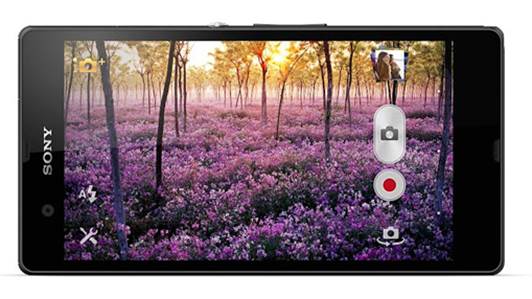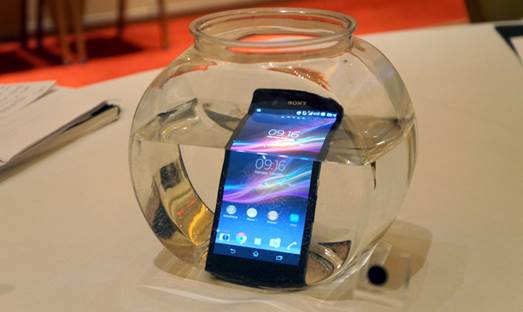Camera test
The Xperia Z is a rare example of a Sony
smartphone without a dedicated camera button. In our view it’s a backward step
for a device that has lots of potential in the imaging department, but it does
bring it into line with most other handsets. As the device we were testing was
not running final firmware it is possible that there will be further improvements
in the quality of the camera by the time the device goes on sale, but in our
initial tests we were happy with the quality and performance of the camera. It
is very responsive, with barely any perceptible shutter lag and produced
reasonably crisp shots in far-from-ideal shooting conditions. There was
inevitably evidence of noise and noise reduction, and the LED flash seems set
to be as feeble as they always are. But from what we’ve seen so far we’d have
no reason not to expect this to match, if not surpass, the performance of the
Xperia T, which is among our current favorite camera smartphone performers.
The full HD display
“You really cannot see the pixels no
matter how closely you look”
One of the big standout features on the
Xperia Z is the screen. This is the first time we’ve seen a 1080p display in
the UK, with the only previous models being a couple of HTC devices for the US
and Japanese markets. The pixel density of 441ppi puts it way beyond Apple’s
famed Retina display benchmark of 300ppi. The theory is that once you get
beyond 300ppi the pixels become imperceptible to the eye, but the Xperia Z’s
screen shows that this is not the case. True, when you’re looking at it in
isolation you might struggle to notice the improvements this higher-than-ever
pixel density makes. It looks bright, clear and crisp, and you really cannot
see the pixels no matter how closely you look. But it’s only when you put it
directly up against a 720p display that you can see how much of a step up it
is.

The
pixel density of 441ppi puts it way beyond Apple’s famed Retina display
benchmark of 300ppi
Whether it proves to be a major selling
point we’re not so sure, but we can certainly expect the entire industry to
move to these HD displays this year. Away from the resolution the screen looks
like being one of Sony’s best. When we reviewed the Xperia T we found the
viewing angles were a notch lower than the likes of the best-in-class HTC One
X, but that appears to have been fixed in the Z. The on-board Bravia engine
ensures good colors and contrast too.
Lifeproof
The Xperia Z will withstand dust, water and
anything else you can throw at it One of the differentiating features of the
Xperia Z, and something that is likely to become commonplace on Sony devices in
future, is that it is waterproof. This means that the ports around the device
are sealed, but we can’t vouch for what will happen if the phone comes into
heavy contact with water when, for example, you’ve got your headphones plugged
in and there is a port exposed. With all the ports closed, though, we can say
that the phone continues to work fully when submerged. That’s great for when
you’re using the device in the rain, although whether you’d want to pluck it
out of the toilet and continue using it is another matter.

The
Xperia Z will withstand dust, water and anything else you can throw at it One
of the differentiating features of the Xperia Z
Benchmark tests
Normally we wouldn’t benchmark a device
running pre-release firmware, but in the case of the Xperia Z there’s really
nothing to hide. The quad-core Krait processor has proven itself before in
devices like the Nexus 4 and there’s no sign that the experience will be any
different on the Xperia Z. It beat the Galaxy S III in both the AnTuTu and
Quadrant benchmark tests, which test CPU, graphics and SD card reading and
writing performance.

It
beat the Galaxy S III in both the AnTuTu and Quadrant benchmark tests
Sony’s software skin
The skin on Sony’s Android smartphones has
for some time been considered one of the best, achieving the aim of giving Sony
handsets their own identity while remaining fairly light and understated.
Sony’s tweaks to the UI have in the past found their way into the stock Android
OS, and there are a few on the Z that we’d be happy to see do likewise. Most
notably is the ability to create folders of apps in the app drawer itself, not
just on the home screen. That would certainly go some way towards helping clear
up the clutter of apps, as well as bloatware. There is a certain amount of the
latter evident on the Sony Sony Xperia Z. Sony, like Samsung, is increasingly
keen to turn its phones and tablets into hubs for all of its products. If you
own a PlayStation and a recent Sony TV and want to invest in Sony services then
the benefits of owning a Sony phone become clearer, but if not, then some of
the added software features on the Z may not be relevant to you.

Sony’s
software skin
Among the added software are a Walkman app
and the (subscription-based) Music Unlimited service that replicates much of
the Google Play Music experience. There’s also a movies service, and a pictures
app to replace the stock Android gallery. For gamers, PlayStation Mobile is
included, although that service has yet to gain any traction in the market.
There are some extras too that offer varying levels of value – bundling
security software always seems like a throwback to the old PC days, while Sony
Car, with its large buttoned UI for in-car control of music and navigation
features seems like it would be of greater use.
Early performance tests
The device we were using was not running
the final firmware so we’ll withhold our judgment on the device’s performance
until we get a retail unit for our full review.
That said, we encountered no issues with
the speed and responsiveness of the system, and the running of some benchmark
tests on the device gave us very high expectations of the phone’s speed. Even
pushing around more than double the pixels as the Galaxy S III, the Krait
processor was able to take everything in its stride make no mistake, this is a
real powerhouse of a smartphone. And just in general use our perceptions are
similar. There are no traces of lag, and games and full HD video ran smoothly.

Samsung
may finally have itself an Android rival
The one concern may be the battery life,
and this was something we have not yet had chance to test. The device is
equipped with a 2100mAh battery, the same size as in the Nexus 4 which was able
to run for just about a day on a single charge. With larger screen size,
greater resolution and 4G connectivity there may need to be some heavy
optimizations to deliver good results with this battery. With this in mind Sony
has incorporated a power management function into the device which disables
certain functions when the screen is off or the battery is low. It will also
give you a handy prediction of how long your battery is likely to last.
Conclusion
The Xperia Z made a good impression on us
during our hands-on time with the device. We’re not overly keen on the styling,
although the fiercely minimalist design is by no means unattractive, but the
screen and the general feeling of power and responsiveness are undoubtedly
appealing.
With a skin that is lighter and more
sophisticated than both HTC and Samsung have been able to muster to date, and
one of the best records for delivering updates, there appears to be nothing on
the software side to scare off users who prefer their Android devices to be up
to date and unencumbered by bloat. And if the phone doesn’t feel like a massive
leap forward over the market leading Galaxy S III, there is surely enough here
to help Sony build on its second-place position.